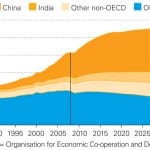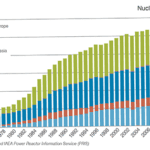Nuclear energy will be key to combating climate change, and nearly 25% of global electricity could be generated from nuclear reactors by 2050, the International Energy Agency (IEA) said in its Nuclear Energy Technology Roadmap, released today.
That expansion would require nuclear generating capacity to more than triple over the next 40 years. According to the organization that acts as an energy policy advisor for the governments of its 28 member countries, the target is “ambitious but achievable.”
The IEA estimated that nuclear generating capacity worldwide is currently 370 GW, providing 14% of global electricity. In the IEA scenario for a 50% cut in energy-related CO2 emissions by 2050 (known as the “BLUE Map” scenario), on which the roadmap analysis is based, nuclear capacity grows to 1,200 GW by 2050, providing 24% of global electricity at that time. Total electricity production in the scenario more than doubles, from just under 20,000 TWh in 2007 to around 41,000 TWh in 2050.
Among the nuclear roadmap’s (PDF) other key findings are that nuclear power is a “mature” technology that is ready to expand rapidly over the coming decades. “The latest reactor designs, now under construction around the world, build on over 50 years of technology development.” Yet the roadmap notes that these designs will need to be fully established as reliable and competitive electricity generators over the next few years if they are to become the mainstays of nuclear expansion after 2020.
No major technological breakthroughs will be needed to achieve the level of nuclear expansion envisaged, the roadmap finds. However, important policy-related, industrial, financial, and public acceptance barriers to the rapid growth of nuclear power remain.
The roadmap sets out an action plan with steps that will need to be taken by governments, industry and others to overcome these. “A clear and stable policy commitment to nuclear energy as part of overall energy strategy is a pre-requisite, as is gaining greater public acceptance for nuclear programmes. Progress in implementing plans for the disposal of high-level radioactive waste will also be vital. The international system of safeguards to prevent proliferation of nuclear technology and materials must be maintained and strengthened where necessary,” the IEA said.
A major challenge expected in many countries is financing the construction of new nuclear plants. The IEA projects that in some cases, governments may need to support nuclear investment through measures such as loan guarantees until nuclear power programs are well-established. The industrial capacities and skilled human resources necessary to build, operate and maintain nuclear plants will also need to be increased over the next few years if nuclear is to expand rapidly, it notes.
“For the longer term, the continued development of reactor and fuel cycle technologies will be important for maintaining the competitiveness of nuclear energy,” the IEA also found. Technologies now under development for next-generation nuclear systems potentially offer improved sustainability, economics, safety and reliability. Some could be suitable for a wider range of locations and to new applications beyond electricity production, for example to provide industrial heat. “Such systems could start contributing to energy supply before 2050,” it said.
The IEA’s roadmaps were developed in response to a June 2008 meeting in which G8 countries acknowledged the need to deploy low-carbon energy technologies to address energy security, climate change, and economic growth. The IEA’s roadmaps “identify priority actions for governments, industry, financial partners and civil society that will advance technology development and uptake to achieve international climate change goals,” it says on its website.
Sources: IEA, POWERnews









